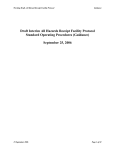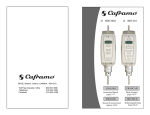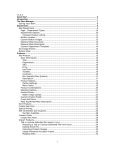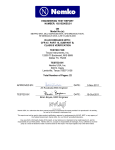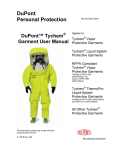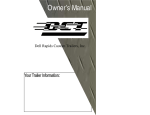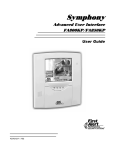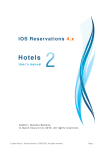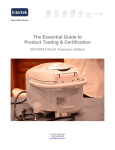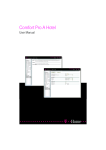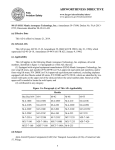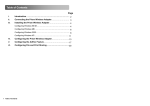Download Electrified Door Hardware White Paperx
Transcript
Electrified Door Hardware Why Planning for FCC Certification is Key to Success in the Door Hardware Industry For more information about Intertek’s testing and certification capabilities, please contact Intertek at 1-800-WORLDLAB, email [email protected], or visit our website at www.intertek.com. Electrified Door Hardware Introduction The once iconic hotel key has quietly faded into memory, now replaced by the less elegant, but far more practical—and secure—magnetic badge. Hotel guests merely insert and retract the badge from the door lock apparatus and a tiny green light signals a welcome for weary travelers. Lost card? No problem. A new badge can quickly be programmed, saving time and stress for guests and hoteliers alike. Likewise, it is common-place for office workers to gain access into buildings with the swipe of a badge. Data stored on the badge controls what floors and areas the employees can access and can also be set to expire at particular times, as in the case with contract and other temporary workers. Electronic access control (EAC) has become a pervasive technology, providing ease and convenience for those who use it. It has brought about the convergence of multiple, disparate systems that will work in harmony to meet the emerging needs of security customers. As EAC systems continue to replace traditional doors and basic door hardware, the door hardware industry is realizing the benefit of forming strong relationships with EAC integrators that provide reliable IT services. Forward-thinking door hardware manufacturers will stay ahead of the competition by putting a plan into place to ensure that their devices are both mechanical and electromechanical certified. As part of the plan, manufacturers must know the Federal Communications Commission (FCC) requirements and how they apply to different devices that comprise an EAC. Though familiar with the mechanical certification, door hardware manufacturers may be less familiar with regulations regarding electromagnetic energy, which is naturally emitted from electronic equipment. The FCC requires equipment, such as that used in EAC systems, to demonstrate compliance to regulations by formal testing, with results documented in a comprehensive test report. This white paper provides an overview of the FCC regulations that apply to EAC system components in order to help door hardware manufacturers prepare for their necessary certifications. Is My Product Regulated By the FCC? FCC regulations are designed to prevent harmful interference to radio communication from radio receivers and other devices that radiate radio frequency energy, and provides for the certification of radio receivers. It also provides for the certification of low power transmitters and for the operation of certificated transmitters without a license. www.intertek.com 1 Electrified Door Hardware The following are examples of products that are regulated by the FCC: • • • • Electronic access controls Smart card credentials and employee ID systems Surveillance systems, Fire safety alarms, perimeter alarms IT equipment that is used to network these systems Different Types of FCC Authorization Procedures For the ease of determining the applicable FCC rule parts and Authorization Procedure, it is helpful to classify a product into one of two groups: Unintentional radiator or Intentional radiator. Most EAC systems use components that fall under the grouping of unintentional radiators. Devices such as information technology equipment (that is, any equipment that has a primary function of either entry, storage, display, retrieval, transmission, processing, switching, or control of data), receivers, and similar devices that are not intended to radiate RF energy are unintentional radiators A device that intentionally generates and emits RF energy by radiation or induction is classified as an intentional radiator. However this document addresses specifically the unintentional type of hardware and additional information regarding intentional radiators are in the appendix. Below is an abbreviated list of equipment types and the applicable Authorization Procedure. The Verification and Declaration of Conformity procedures will apply to unintentional radiators, and the Certification procedure will apply to intentional radiators. Equipment Authorization Personal Computers & Peripherals Declaration of Conformity: Manufacturer uses accredited lab to determine compliance Most Part 15 Transmitters Certification: Representative test results and technical file are certified by the FCC or designated Telecommunication Certification Body (TCB) Most Other Digital Equipment (Unintentional Radiator) Verification: Manufacturer determines compliance, affirms it with label and paperwork www.intertek.com 2 Electrified Door Hardware Class A or Class B Products subject to Verification can be evaluated to two different Classes, with Class A limits being less stringent than Class B limits. A key concept to remember is that equipment that meets Class B limits do not have any restrictions on where they can be used. Equipment meeting Class A limits can only be used in commercial, business and industrial environments but not residential environments. Class A Digital Device: "A digital device that is marketed for use in a commercial, industrial or business environment; exclusive of a device which is marketed for use by the general public, or which is intended to be used in the home." Class B Digital Device: “A digital device that is marketed for use in a residential environment notwithstanding use in commercial, business and industrial environment.” (Quoted from Code of Federal Regulations Title 47, Part 15 Subpart A, 15.3) Specific FCC Rule Parts The following is a summary of some of the specific rule parts under Part 15 Subpart B which covers rules for unintentional radiators. Part 15 Subpart B: • 15.101 - Equipment authorization of unintentional radiators • 15.103 - Exempted devices • 15.105 - Information to the user • 15.107 - Line conducted emissions • 15.109 - Radiated emissions, 30 MHz and up Note: Requirements for intentional radiators are provided in the appendix Requirements for Unintentional Radiators There are two basic FCC tests that need to be performed on unintentional radiators: • • Radiated Emissions Line Conducted Emissions The requirements and procedures for performing these tests are outlined in the standard ANSI C63.4-2009. www.intertek.com 3 Electrified Door Hardware Testing for Radiating Emissions All unintentional radiators will have to meet the requirements for Radiated emissions, which is the measurement of electromagnetic noise that is emanated through the air from the Equipment Under Test (EUT). The measurement is made on a special test site that meets the Normalized Site Attenuation (NSA) requirements of ANSI C63.4. The test site can be of either two types, an OATS (Open Area Test Site) or an ATS (Alternative Test Site). An OATS site is an open, flat, level area that is clear of overhead wires and reflecting structures, and sufficiently large to permit measuring antenna placement at the specified distance. An Alternative Test Site can be a RF absorber-lined, metal test chambers, office or factory buildings, or weather-protected OATS with covering structures that are or become significantly reflective with weather. The EUT is placed on a turntable which is remotely controlled to spin 360 degrees. A measuring antenna is placed on a remotely controlled antenna mast that is capable of adjusting a linearly polarized antenna between 1 – 4 meters in height. The specified frequency range is scanned by the measuring instrument while the turntable angle, antenna height and antenna polarization are varied to capture the worst case emissions. Making accurate measurements for radiated emissions on an OATS can be difficult if there are ambient signals from local broadcast stations or digital equipment operating close by. One of the major benefits of choosing an ATS, such as a semi-anechoic chamber, to perform radiated emissions is that interference from ambient signals is minimized. When selecting a testing partner, look for one that offers ATS facilities. Intertek can provide a 10 meter semi-anechoic chamber for testing purposes, as shown in the following photos. www.intertek.com 4 Electrified Door Hardware Testing for Conducted Emissions If the device is connected to the public AC network for power, then line conducted emissions test must be performed on the AC power port. This test measures how much radio-noise emissions the EUT is coupling back onto the AC network. Noise is measured on the power cord from the EUT by a measuring port that feeds the electromagnetic noise into the measuring instrument. Test Reporting All test reports must accurately document the test configuration and measurement results. The report must contain the following information: System configuration: • Models, serial numbers, FCC identifiers • Operating Modes • Cable/accessory information: o Number o Length o Construction: Shielded, boots, ferrite Description of any modifications made during the tests Signed by test personnel with pass/fail compliance statement The test report does not have to be filed with the FCC. The test report is maintained by the manufacturer and a Declaration of Conformity is created to demonstrate compliance. Labeling Requirements The basic label information from FCC Part 15.19 is used on almost all devices: This device complies with Part 15 of the FCC rules, and operation is subject to the following two conditions: 1. This device may not cause harmful interference 2. This device must accept any interference received, including interference that may cause undesired operation. Specific wording for Class A (commercial) and Class B (residential) computing devices can be found in the appendix. Your testing vendor can work with you to create the correct labeling, compliant with FCC regulations. www.intertek.com 5 Electrified Door Hardware Summary Most products incorporating some form of digital circuitry will require testing to FCC Part 15. Unintentional radiators are authorized under the Verification or Declaration of Conformity procedures which require testing of the product. The test report is not filed with the FCC, it is maintained internally by the manufacturer. Intentional radiators must be authorized through the Certification procedure which requires testing of the product and an application filing with the FCC. Reading through and trying to understand the FCC rules can be puzzling if you are new to FCC Part 15 rules. An experienced independent test laboratory can be of assistance to guide you through the process. With its global network of 23 EMC testing labs, Intertek can provide the capacity, proximity and engineering resources to streamline the EMC compliance testing process for any market you want to reach. Intertek holds a long list of EMC accreditations from around the world, with queue times as fast as 3 days. We offer both open and fully sheltered sites, fully anechoic and semianechoic chambers, with site size ranging from 3 meters to 10 meters. As part of our green initiative Intertek can test your unintentional radiators to verify compliance with applicable regulations that restrict the use of certain hazardous substances and/or require disclosure to customers and consumers if certain substances are present in electronic products (e.g. California Proposition 65, EU REACH and EU RoHS). Save time and money by bundling EMC with other testing and certification needs (Safety, Environmental, Energy Efficiency, and Performance). With Intertek you will eliminate the headaches of using multiple labs, delays in logistics and shipping costs. References Electronic Code of Federal Regulations Title 47, http://ecfr.gpoaccess.gov ANSI C63.4-2009 Ollie Moyrong is an Engineering Manager with Intertek, Commercial & Electrical Division, located in Menlo Park, CA. He has over 15 years of experience testing in the field of EMI/EMC and serves as a member of the IEEE EMC Society. He is a Telecommunication Certification Body (TCB) for the FCC, an Industry Canada Foreign Certification Body (FCB) and a Conformity Assessment Body (CAB) for the European Union for the EMC and R&TTE Directives. www.intertek.com 6 Electrified Door Hardware Appendix Overview of FCC Rules The FCC rules can be found in the Code of Federal Regulations (CFR) Title 47, Telecommunications. Relevant parts from CFR 47 Part 0, commission organization - Part 0 describes the structure and functions of the Commission, lists delegations of authority to the staff, and sets forth information designed to assist those desiring to obtain information from, or to do business with, the Commission. Part 1, practice and procedure - Part 1, subpart A, contains the general rules of practice and procedure. Part 2, frequency allocations and radio treaty matters; general rules and regulations - Part 2 will be of interest to all persons interested in the use of radio. It contains definitions of technical terms used in the rules and regulations. Part 15, radio frequency devices - Part 15 contains regulations designed to prevent harmful interference to radio communication from radio receivers and other devices which radiate radio frequency energy, and provides for the certification of radio receivers. It also provides for the certification of low power transmitters and for the operation of certificated transmitters without a license. Parts 0–19 of the rules have been reserved for provisions of a general nature. Parts 20–69 have been reserved for provisions pertaining to common carriers. Parts 20–29 and 80–109 have been reserved for provisions pertaining to the wireless telecommunications services. In the rules pertaining to common carriers, parts 20–25 and 80–99 of this chapter pertain to the use of radio. In the rules pertaining to common carriers, parts 21, 23, and 25 of this chapter pertain to the use of radio. Parts 31–66 of this chapter pertain primarily to telephone and telegraph companies. Persons having business with the Commission will find it useful to consult one or more of these parts containing provisions of a general nature in addition to the rules of the radio or wire communication service in which they are interested. www.intertek.com 7 Electrified Door Hardware Rule Parts for Intentional Radiators Below is a summary of some of the specific rule parts under Part 15 Subpart C which covers rules for Intentional Radiators. Part 15 Subpart C: • 15.201(b) - Certification required • 15.203 - Integral antenna or special connector • 15.205 - Restricted frequency bands • 15.207 - Line conducted emissions • 15.209 - Radiated emissions and general requirements, 9 kHz and up • 15.219 - Operation in the band 510-1705 kHz, local AM radio • 15.223 - Operation in the band 1.705-10 MHz, perimeter protection • 15.225 - Operation in the band 13.11-14.01 MHz, RFID etc. • 15.227 - Operation in the band 26.96-27.28 MHz, toy control • 15.229 - Operation in the band 40.66-40.7 MHz • 15.231 - Periodic operation, remote controls • 15.239 - Operation in the band 88-108 MHz, local FM radio • 15.240 - Operation in the band 433.5-434.5 MHz, RFID • 15.245 - Bands 915 MHz, 2.45 GHz, 5.8 GHz field disturbance; 10.5 GHz, 24 GHz ………...door openers • 15.247 - Bands 915 MHz, 2.45 GHz, 5.8 GHz spread spectrum • 15.249 - Bands 915 MHz, 2.45 GHz, 5.8 GHz, portable phones, wireless ………...audio/video • 15.401 - U-NII, 5.25 GHz and 5. 8 GHz bands wireless data Some examples of commonly used frequencies and their applicable rules parts: Device RF ID device operating at 13.56 MHz Wireless Remote Control, Periodic Operation at 433 MHz Remote Control and monitoring applications using ZigBee protocol operating at 2.4 GHz Specific FCC Rule Part 15.225 15.231 15.247 Requirements for Intentional Radiators The required testing for intentional radiators is similar to that of unintentional radiators with the addition of tests related to the operating parameters regulated by the specific rule part. For example, RF ID equipment operating at 13.56 MHz under FCC rule 15.225 must meet the specific requirements for radiated emissions, occupied bandwidth and frequency tolerance while varying the temperature and supply voltage. The documentation required for an intentional radiator is much more complex than what is required for an unintentional radiator. www.intertek.com 8 Electrified Door Hardware All applications for unlicensed transmitter certification must be filed electronically (either with FCC or TCB) and must contain the following exhibits: CFR 47 Rule Part Item 2.1033(a) Form 731 Cover letter, for confidentiality or Permissive Change Attestation statements to specific requirements User’s Manual Operational Description Block Diagram Schematics Test Report Test Setup Photos External Product Photos FCC ID Label and Location Internal Product Photos RF Exposure Information, only for some products 2.932, 2.1043 2.1033(b)(10)-(11) 2.1033(b)(3) 2.1033(b)(4) 2.1033(b)(5) 2.1033(b)(6) 2.1033(b)(6)-(8) 2.1033(b)(6) 2.1033(b)(7) 2.1033(b)(7) 2.1033(b)(7) 2.1033(b)(12), 2.1091/93 Once the application has been filed, all of the documents can be publicly viewed on the FCC’s website. The FCC does allow provisions for a company to keep proprietary information confidential such as schematics, block diagrams and operational descriptions provided that a request for Confidentiality has been filed stating a valid reason for the request. A TCB (Telecommunication Certification Body) is designated by the FCC to approve equipment under the Certification procedure based on an application with all the specified information. The TCB processes the application to determine whether the product meets the Commission's requirements and issues a written grant of equipment authorization. The grant identifies the TCB and the source of authority for issuing it. www.intertek.com 9 Electrified Door Hardware Labeling Requirements If the device is subject to Certification, then the FCC ID must be printed on the label along with the two part statement. FCC ID:XXXYYYYY This device complies with Part 15 of the FCC Rules. Operation is subject the following two conditions: (1) This device may not cause interference, and (2) this device must accept any interference received, including interference that may cause undesired operation. An FCC ID consists of a set of three alphanumeric characters assigned by the FCC to a particular company followed by a set of 1-14 alphanumeric characters (including the "-") which is unique for the model it identifies. FCC ID: Grantee Code XXX YYYYYYY Product Code The Label Information The label information from 15.105 (a) Class A (commercial) Computing Device: Information to User: For a Class A digital device or peripheral, the instructions furnished the user shall include the following or similar statement, placed in a prominent location in the text of the manual: Note: This equipment has been tested and found to comply with the limits for a Class A digital device, pursuant to Part 15 of the FCC Rules. These limits are designed to provide reasonable protection against harmful interference when the equipment is operated in a commercial environment. This equipment generates, uses, and can radiate radio frequency energy and, if not installed and used in accordance with the instruction manual, may cause harmful interference to radio communications. Operation of this equipment in a residential area is likely to cause harmful interference in which case the user will be required to correct the interference at his own expense. The label information from 15.105(b) Class B Computing Device: Information to User For a Class B digital device or peripheral, the instructions furnished the user shall include the following or similar statement, placed in a pertinent location in the text of the manual: www.intertek.com 10 Electrified Door Hardware Note: This equipment has been tested and found to comply with the limits for a Class B digital device, pursuant to Part 15 of the FCC Rules. These limits are designed to provide reasonable protection against harmful interference in a residential installation. This equipment generates, uses and can radiate radio frequency energy and, if not installed and used in accordance with the instructions, may cause harmful interference to radio communications. However, there is no guarantee that interference will not occur in a particular installation. If this equipment does cause harmful interference to radio or television reception, which can be determined by turning the equipment off and on, the user is encouraged to try to correct the interference by one or more of the following measures: • • • • Reorient or relocate the receiving antenna. Increase the separation between the equipment and receiver. Connect the equipment into an outlet on a circuit different from that to which the receiver is connected. Consult the dealer or an experienced radio/TV technician for help. Special Accessories: Where special accessories, such as shielded cables, are required in order to meet FCC emissions limits, appropriate instructions on the need to use such equipment must be contained in the user manual. Note: States that the user’s manual shall caution the user that changes or modification to the product could void the user's FCC authority to operate the equipment. About Intertek Intertek is a leading provider of quality and safety solutions serving a wide range of industries around the world. From auditing and inspection, to testing, quality assurance and certification, Intertek people are dedicated to adding value to customers' products and processes, supporting their success in the global marketplace. Intertek has the expertise, resources and global reach to support its customers through its network of more than 1,000 laboratories and offices and 30,000 people in over 100 countries around the world. Intertek Group plc (LSE: ITRK) is listed on the London Stock Exchange and is a constituent of the FTSE 100 index. Visit: www.intertek.com This publication is copyright Intertek and may not be reproduced or transmitted in any form in whole or in part without the prior written permission of Intertek. While due care has been taken during the preparation of this document, Intertek cannot be held responsible for the accuracy of the information herein or for any consequence arising from it. Clients are encouraged to seek Intertek’s current advice on their specific needs before acting upon any of the content. www.intertek.com 11














